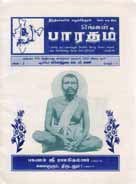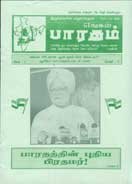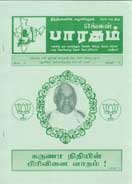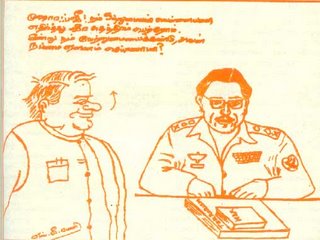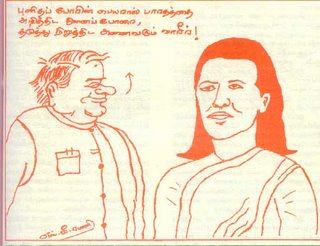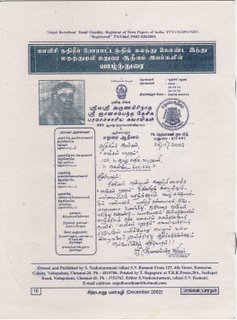
In olden days marriages are matched by Horoscopes. At present days marriages are matched by Hearts. In both cases there are problems and divorces. What is the reason for this ? Can any body explain the reason for this? After that I will explain my opinion.You can contact me at email. engalbaratham@hotmail.com For finding suitable Bride/Bridegroom Please visit.http://ramanisweet.googlepages.com/ {The only Matrimonial Service in Chennai, Tamil Nadu, India doing free Matrimonial Services}
Great jollyboy Videos gives great entertainment.
Please visit and know the truth about the world.
Click Here and get suitable Matrimonial Match
immediately.
You can find your life partner here..!
Baratha Bhoomi.. You can Read Daily News from Here.
Full Web Building Tutorials for Free!
Mahakavi Bharathi.
Mahakavi Bharathi songs created patriotism in the mind of Indians.
மகா கவி பாரதியின் பாடல்கள் இந்திய மக்கள் உள்ளங்களிலே
விடுதலை உணர்வைத்
தூண்டியது.
Ramani free matrimonial services for all Hindu community people throughout the world.Donate.
Let us learn Tamil,English,Kannada,Telungu,Malayalam and Urudu and also teach our children.
Let us learn Tamil,English,Kannada,Telungu,Malayalam and Urudu and also teach our children. . Click on the picture.
தமிழக அரசின் பாடப் புத்தகங்கள் மூலம், தமிழைகயும் மற்ற ஆங்கிலம்,கன்னடம்,தெலுங்கு,மலையாளம் மற்றும் உருது மொழிகளைக் கற்று, நமது குழந்தைகளுக்கும் போதிப்போம். . படத்தின் மேல் கிளிக் செய்யவும்.


Full Web Building TutorialsALL FREE!
Quick and Easy Learningclick on the picture.

Custom Search
Tuesday, August 29, 2006
Saturday, August 26, 2006
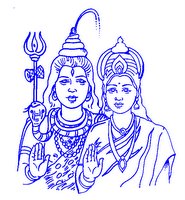
Mount Kailash.
[The abode of God Siva]
The Indian Vedas speak of “Meru” or “Sumeru” as being at the centre of the universe, which is perhaps symbolized by the Holy Mount Kailash, the abode of God “Siva”. The Himalaya Mountain sprang from the sea-bed a large number of lakes and rivers were created. It is faith of all people of India that Lord Siva is residing in the Mount Kailash. According to “Skanda Purana” there are Forty thousand Holy places at Lake “Manasarovar” which is fed by fourteen major rivers.
In South India, the dance of Lord Siva represents the rhythm and movement of the world spirit. One can witness the dance of Siva in the rising sun, in the waves of the Ocean, in the rotation of the planets, in the lightning of the thunder.
All the creations in the world evolve from the combination of the five elements earth, water, fire, air and ether. According to South Indian tradition Lord Siva is worshipped as “Prithvi or earth” at Kanchipuram, as “Appu or water” at Jambukeswaram as “Tejas or fire” ar Tiruvannamalai, as Vayu or Air” at Kalahasti and as “Akasa or ether” at Chidambaram.
If Siva is the Omnipotent God without form, the Sivalinga is the nearest manifestation of his formlessness as the unknown Deity. Who in his play once manifested himself as large columns of fire? The Gods Brahma and Vishnu attempted to discover the top and bottom extremities of this column but failed.

God Siva and Parvati marriages in all temples of India symbolize the most ancient sacred type of marriages. Even to-day singing of Siva’s marriage [Gowri Kalyanam] verse is a must in all auspicious occasions all over India. This indicates that early man conceived or civilized family life through the worship of Lord Siva.
There are many legends about the circumambulation of Mount Kailash. No one can normally approach the inner Sanctum Sanctorum, the real abode of Lord Siva and Parvati Devi, through these valleys even though it appears so easy. The Tamil people have for long worshipped God Siva as light. Earlier Sivalinga described as triangular stone was the form of Sivalinga worship.
[For Hindu community marriage alliances visit. http://ramanisweet.googlepages.com/ ]
Sunday, August 20, 2006
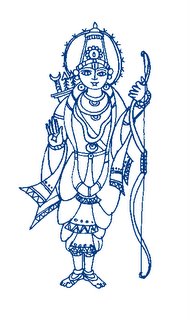
Faith in worshipping God.
In Hindu Purana there is one story. King Hiranyakasupu asked his son Prakalatha “Where is the God hiding?” Prakalatha replied “He is not hiding anywhere and he is living in all the places including Sky, Water, Fire, and Pillar and even in small piece of Dust. If a devotee believes that his chosen ideal is God then he attains God and sees him”.
People of Old generations had tremendous faith on God. Once a farmer was on the way to his daughter’s house. On the way he noticed some beautiful flowers and bel leaves. He gathered them for worship of the family deity and walked back six or seven miles to his own house in a remote village.
Once a folk dance troupe in the farmer’s village was enacting a drama on the life of Rama. In the drama getting throne for his son Barathan, the {actress} Kaikeyi asked Rama to go into exile in the forest for fourteen years. All people seeing the cruel words of Kaikeyi really wept with tears. The old farmer having faith on God Rama went to the actress who played the role of Kaikeyi crying out “You wretch, you must go to forest” and was about to attack the actress with stick. It shows the real heart of the farmer who is having so real faith with God Rama.
Everybody might have heard about the tremendous power of faith in Hindu puranas {History]. It is said in the “Ramayana “ [Story of Ayodhya king Rama].that Rama who was God himself –the embodiment of absolute Brahman-had to build a bridge to cross the sea to Ceylon. But Hanuman chanting in Rama’s name crossed the sea in one jump and reached the other side. He had an unbreakable faith with Rama’s name and there is no need of bridge for him. On the faith of a name impossible things are made possible.
Therefore every person must have true faith and earnest longing, and then we will get everything by the Grace of God.
[Barathabhoomi will continue]
Friday, August 18, 2006
Islam Teaches Muslims to be kind and Compassionate.
Mohammed the Prophet was born at Mecca in 570 A.D. in the respected House of Abdullah of the Hashmites, of the tribes of the qurasish.At the age of forty Mohammed began gaining a spiritual experience while visiting Mount Hills three miles from Mecca. .
As a result of a whole month of rich spiritual experience, he was under believe that he has a mission to fulfil, namely to guide his countrymen and a mankind along a path leading to everlasting peace. A vision is said to have announced to him that he was the Prophet of Allah.
Prophet Mohammed therefore, began to preach his doctrines of Allah or the one true God. God’s message thro Mohammed to mankind is incorporated in Holu “Koran”. His new faith was named as “Islam” literally meaning “Surrender”. Those who surrender to God are called Mussalmans or Muslims.
The teachings of Islam is as under:-
1. Oneness of God or strict monotheism “There is no god, but Allah, and Mohammed is his Prophet.
2. Prayers to God at least five times a day.
3. All mankind is a brotherhood.
4. The faithful must help their brethren according to their means, and charity must become a habit with a true Muslim.
5. Respect for women.
6. Surrender of oneself to Allah.
Islam also enjoins fasting in the month of Ramzon and vist to the places of faith viz., Mecca, Medina, etc., at least once in a life time. Islam also calls upon the faithful not to drink wine, consume pork, gamble, steel, and slander others or commit murder. It expects all Muslims to be kind and compassionate to the poor, sick, the orphans and the widows.
From the above, we can understand that Islam teaches mankind to all in the world. Particularly Muslim terrorists, if they want to follow the principals of the Islam, they must stop their killing activities in Jammu and Kashmir and also in other parts of the World. True Muslim who follows the footstep of Allah must come forward to preach the teachings of Mankind to the world.
[Barathabhoomi will continue]
Mohammed the Prophet was born at Mecca in 570 A.D. in the respected House of Abdullah of the Hashmites, of the tribes of the qurasish.At the age of forty Mohammed began gaining a spiritual experience while visiting Mount Hills three miles from Mecca. .
As a result of a whole month of rich spiritual experience, he was under believe that he has a mission to fulfil, namely to guide his countrymen and a mankind along a path leading to everlasting peace. A vision is said to have announced to him that he was the Prophet of Allah.
Prophet Mohammed therefore, began to preach his doctrines of Allah or the one true God. God’s message thro Mohammed to mankind is incorporated in Holu “Koran”. His new faith was named as “Islam” literally meaning “Surrender”. Those who surrender to God are called Mussalmans or Muslims.
The teachings of Islam is as under:-
1. Oneness of God or strict monotheism “There is no god, but Allah, and Mohammed is his Prophet.
2. Prayers to God at least five times a day.
3. All mankind is a brotherhood.
4. The faithful must help their brethren according to their means, and charity must become a habit with a true Muslim.
5. Respect for women.
6. Surrender of oneself to Allah.
Islam also enjoins fasting in the month of Ramzon and vist to the places of faith viz., Mecca, Medina, etc., at least once in a life time. Islam also calls upon the faithful not to drink wine, consume pork, gamble, steel, and slander others or commit murder. It expects all Muslims to be kind and compassionate to the poor, sick, the orphans and the widows.
From the above, we can understand that Islam teaches mankind to all in the world. Particularly Muslim terrorists, if they want to follow the principals of the Islam, they must stop their killing activities in Jammu and Kashmir and also in other parts of the World. True Muslim who follows the footstep of Allah must come forward to preach the teachings of Mankind to the world.
[Barathabhoomi will continue]
Tuesday, August 15, 2006
Muslim invasion in India.
In India Mohmud Ghazni dynasty was short lived. After him Afghan high Landers from Ghor [Between Ghazni and Herat] who sacked Ghazni in 1155 and putting all males to death. Little remains there today to remind posterity of the reign of the Ghaznavide, save the tomb of Mahmud Ghazni.
The peace which India has enjoyed for more than a century was once again to be rudely broken. A Nephew of the man who sacked Mohamud Ghazni eventually set up his throne viz Muizz-ud-din, commonly known as Mohamud Ghori. This man like Ghazni before him was the Ruler of India for thirty years.
He made in his first business to consolidate Muslim gains in India and ride himself of Muslim rivals. By this was he brought under his control the old Arab Colony on the Indus, captured Multan and Sind. In 1184 he ravaged the district of Lahore and fortified Sialkot. Thus established he turned upon the Hindus, whom he and his fanatical Afghans were only too eager “to send to the fire of hell”. Attempting to seize garrison Sarhind, however he encountered fierce opposition from the Great Rajputs.
The two forces met in 1191, ten miles to the north of karnal near to the Historic battle field of Panipet Muslims attacked the Rajputs in a rude way, but the Muslims were worsted and fled across the Indus.
The Sultan smarted under the defeat and vowing vengeance, returned next year at the head of 1, 20,000 troops composed of Afghans, Turks and Persians. This time the Rajputs
were overthrown with ruthless slaughter. Many Rajput Chiefs were slain, and sent to death. This victory of Muslims led to annexation of Ajmir and other territories in 1192.
Qutb-ud-din, a slave of Muhamud Ghori was appointed as Viceroy of India. Eventually on the death of his master he founded the Empire of Delhi. In the meantime there was much fighting to be done in which the Sultan and Quth-ud-din cooperated. They subdued
The intervening country right up to Banares, Whilst Bakthiyar Khilji, pushing still further east, secured Bengal as a permanent possession for the Muslims.
By killing thousands of Rajputs and Hindus and on their bloodshed the Muslim terrorists entered India and established their Kingdom.
[Muslim invasion will continue]
In India Mohmud Ghazni dynasty was short lived. After him Afghan high Landers from Ghor [Between Ghazni and Herat] who sacked Ghazni in 1155 and putting all males to death. Little remains there today to remind posterity of the reign of the Ghaznavide, save the tomb of Mahmud Ghazni.
The peace which India has enjoyed for more than a century was once again to be rudely broken. A Nephew of the man who sacked Mohamud Ghazni eventually set up his throne viz Muizz-ud-din, commonly known as Mohamud Ghori. This man like Ghazni before him was the Ruler of India for thirty years.
He made in his first business to consolidate Muslim gains in India and ride himself of Muslim rivals. By this was he brought under his control the old Arab Colony on the Indus, captured Multan and Sind. In 1184 he ravaged the district of Lahore and fortified Sialkot. Thus established he turned upon the Hindus, whom he and his fanatical Afghans were only too eager “to send to the fire of hell”. Attempting to seize garrison Sarhind, however he encountered fierce opposition from the Great Rajputs.
The two forces met in 1191, ten miles to the north of karnal near to the Historic battle field of Panipet Muslims attacked the Rajputs in a rude way, but the Muslims were worsted and fled across the Indus.
The Sultan smarted under the defeat and vowing vengeance, returned next year at the head of 1, 20,000 troops composed of Afghans, Turks and Persians. This time the Rajputs
were overthrown with ruthless slaughter. Many Rajput Chiefs were slain, and sent to death. This victory of Muslims led to annexation of Ajmir and other territories in 1192.
Qutb-ud-din, a slave of Muhamud Ghori was appointed as Viceroy of India. Eventually on the death of his master he founded the Empire of Delhi. In the meantime there was much fighting to be done in which the Sultan and Quth-ud-din cooperated. They subdued
The intervening country right up to Banares, Whilst Bakthiyar Khilji, pushing still further east, secured Bengal as a permanent possession for the Muslims.
By killing thousands of Rajputs and Hindus and on their bloodshed the Muslim terrorists entered India and established their Kingdom.
[Muslim invasion will continue]
Wednesday, August 09, 2006
Muslim Invasion in India since Tenth Century.
For nearly 900 years the activities of Muslim Rulers particularly dominate the pages of Indian History. They invaded Indian Country seeing the Great wealth and happy living of people. During the 10th century, Alptapgin a Arab leaving the service of his master in Northern Persia, penetrated into Afghanistan and set up a small Kingdom with its centre at Ghazni. In 962 Subuktigin a slave who succeeded him, was the first Muslim to attempt the invasion of India through the lofty north-west passes, He fought King Jaipal of Punjab and he cannot able to follow up his victories.
Subuktigin was succeeded in 997, by his son Mahmud. Elated by Khalifas blessing on his succession, he there and then resolved to wage a ‘Jihad’ each year against the Hindu Kings at Hindustan. It is calculated that between the years 1000 and 1026 he raided India seventeen times, traversing the ground between the Indus and Ganges. It is particularly to note that he slew tens of thousands of Hindus and took them as slaves. At one time he stormed the fortress of Kangra {Nagarkot} where the Hindu ancestors kept their wealth of treasure and jewels and took them to Ghazni. The treasure he took with him to Ghazni must have been several millions of rupees value.
Thus again and again he swept over the plains of Hindustan conquering Kings and their castles, razing temples and smashing Idols, until he become the terror of the countryside.
Little wonder he earned such titles as ‘Ghazi’ ‘Victor’ and ‘Ideal breaker.’
Mahmud realm by now includes Khursan in Persia and rich territories to the west so that his conquests and his wealth become notorious all over the east. With his rude forces he came again to Hindustan in 1018 and crossing the rivers of Punjab he stood before the temples of Mathura, the ancient centre of Hindu worship. From the temple he gained vast treasure and smashing to pieces of Hindu idols of gold and silver. During the campaign the King was made to surrender before Mahmud and ten thousands of peoples were forced to accept Islam. In subsequent raids also Mahmud overrun Kanoj, Lahore and Gwalior
With his rude warriors he captured Somanath in Gujarat in 1025-26. It is said that several thousands of pilgrims used to assemble at its costly temple, which was served by one thousand Brahman Priests. The temple fame and wealth of its Gems enticed Mahmud to make the exhausting journey across the Rajaputana desert from Multan. He sacked the temple, carrying off to Ghazni the famous Golden gates of the temple and treasure worth one Million pounds sterling.
{Muslim Invasion in India will continue}
For nearly 900 years the activities of Muslim Rulers particularly dominate the pages of Indian History. They invaded Indian Country seeing the Great wealth and happy living of people. During the 10th century, Alptapgin a Arab leaving the service of his master in Northern Persia, penetrated into Afghanistan and set up a small Kingdom with its centre at Ghazni. In 962 Subuktigin a slave who succeeded him, was the first Muslim to attempt the invasion of India through the lofty north-west passes, He fought King Jaipal of Punjab and he cannot able to follow up his victories.
Subuktigin was succeeded in 997, by his son Mahmud. Elated by Khalifas blessing on his succession, he there and then resolved to wage a ‘Jihad’ each year against the Hindu Kings at Hindustan. It is calculated that between the years 1000 and 1026 he raided India seventeen times, traversing the ground between the Indus and Ganges. It is particularly to note that he slew tens of thousands of Hindus and took them as slaves. At one time he stormed the fortress of Kangra {Nagarkot} where the Hindu ancestors kept their wealth of treasure and jewels and took them to Ghazni. The treasure he took with him to Ghazni must have been several millions of rupees value.
Thus again and again he swept over the plains of Hindustan conquering Kings and their castles, razing temples and smashing Idols, until he become the terror of the countryside.
Little wonder he earned such titles as ‘Ghazi’ ‘Victor’ and ‘Ideal breaker.’
Mahmud realm by now includes Khursan in Persia and rich territories to the west so that his conquests and his wealth become notorious all over the east. With his rude forces he came again to Hindustan in 1018 and crossing the rivers of Punjab he stood before the temples of Mathura, the ancient centre of Hindu worship. From the temple he gained vast treasure and smashing to pieces of Hindu idols of gold and silver. During the campaign the King was made to surrender before Mahmud and ten thousands of peoples were forced to accept Islam. In subsequent raids also Mahmud overrun Kanoj, Lahore and Gwalior
With his rude warriors he captured Somanath in Gujarat in 1025-26. It is said that several thousands of pilgrims used to assemble at its costly temple, which was served by one thousand Brahman Priests. The temple fame and wealth of its Gems enticed Mahmud to make the exhausting journey across the Rajaputana desert from Multan. He sacked the temple, carrying off to Ghazni the famous Golden gates of the temple and treasure worth one Million pounds sterling.
{Muslim Invasion in India will continue}
Saturday, August 05, 2006
Kashmir the Home of Learning.
Indian Independence bill was passed through British House Of Lords in the middle of 1947, the Liberal Peer; Lord Samuel hailed it as a peace of treaty without War. By 15th August all that had been Maharaja Harisingh achieved was a stand of still agreement in Kashmir problem.
From the very beginning of the Independence itself Pakistan was very particular about Kashmir and invaded Kashmir with the help of its tribe’s men. The Indian troops were flown in and after a fortnight they beat back the invaders. Still it is continuing in Kashmir with terrific war with Gun by Pakistan activists. They are targeting Hindu places and Temples and daily killing innocent peoples.
Further to the above, I am now going to tell something about the glorious State of Kashmir in 6th century. Kashmir is a very beautiful land with full of lakes and mountains rather like an Indian Switzerland. At the time of Independence Maharaja Harisingh was the ruler of Kashmir. His grandfather had been allowed to buy Kashmir from British, who had inherited it from the Sikh Kingdom of the Punjab. Nehru’s ancestors had come from Kashmir. But realistically, Nehru hated the thought of an India divided by religion.
The famous fourth council of Buddhist scholars was held in “Kundalarana Vihara”in Kashmir. By 6th century A.D. “Mihirgula” of the cruel Huna dynasty came to Kashmir and he was given shelter by the King of Kashmir. Huna killed his benefactor and captured the throne of Kashmir. After him the powerful “Karkota” dynasty was established in Kashmir. The Karkota family was displaced by the “Utpalas” of whom “Avantivarman” helped in constructing temples, lakes and beautiful towns in Kashmir.
After Utpalas the “Loharas” came to power and ruled Kashmir for 125 years. Queen Didda of this family ruled from 958-1000.Kahmir was the Home of learning and culture. Buddhist monasteries were built during the period of Ashoka and Kanishka
During those days, a special school of “Shaivism” was developed by Kashmir famous scholars like Vasugupta, Kallata, Somanda, Utpala etc., on the basis of Shiva-Sutras, a revealed text.
Our prayer is, we must get peace in Kashmir.
Indian Independence bill was passed through British House Of Lords in the middle of 1947, the Liberal Peer; Lord Samuel hailed it as a peace of treaty without War. By 15th August all that had been Maharaja Harisingh achieved was a stand of still agreement in Kashmir problem.
From the very beginning of the Independence itself Pakistan was very particular about Kashmir and invaded Kashmir with the help of its tribe’s men. The Indian troops were flown in and after a fortnight they beat back the invaders. Still it is continuing in Kashmir with terrific war with Gun by Pakistan activists. They are targeting Hindu places and Temples and daily killing innocent peoples.
Further to the above, I am now going to tell something about the glorious State of Kashmir in 6th century. Kashmir is a very beautiful land with full of lakes and mountains rather like an Indian Switzerland. At the time of Independence Maharaja Harisingh was the ruler of Kashmir. His grandfather had been allowed to buy Kashmir from British, who had inherited it from the Sikh Kingdom of the Punjab. Nehru’s ancestors had come from Kashmir. But realistically, Nehru hated the thought of an India divided by religion.
The famous fourth council of Buddhist scholars was held in “Kundalarana Vihara”in Kashmir. By 6th century A.D. “Mihirgula” of the cruel Huna dynasty came to Kashmir and he was given shelter by the King of Kashmir. Huna killed his benefactor and captured the throne of Kashmir. After him the powerful “Karkota” dynasty was established in Kashmir. The Karkota family was displaced by the “Utpalas” of whom “Avantivarman” helped in constructing temples, lakes and beautiful towns in Kashmir.
After Utpalas the “Loharas” came to power and ruled Kashmir for 125 years. Queen Didda of this family ruled from 958-1000.Kahmir was the Home of learning and culture. Buddhist monasteries were built during the period of Ashoka and Kanishka
During those days, a special school of “Shaivism” was developed by Kashmir famous scholars like Vasugupta, Kallata, Somanda, Utpala etc., on the basis of Shiva-Sutras, a revealed text.
Our prayer is, we must get peace in Kashmir.
Thursday, August 03, 2006
Wednesday, August 02, 2006
Subscribe to:
Posts (Atom)
Whether Hindu’s are thieve’s?
Whether Hindu’s are thieve’s?இந்துக்கள் திருடர்களா? கருணாநிதிக்கு எஸ்.வி.ரமணியின் பதில்கள்










